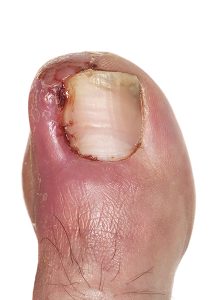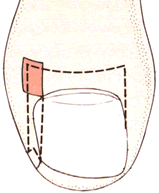Ingrowing nails
Ingrowing nails
 Ingrown nails occur most commonly on the big toe and are caused by either poor nail cutting technique, tight shoes, or just plain bad luck if you have wide or highly curved nails. Nails can become painful along the sides if they curve downwards into the flesh of the toe or become excessively thick; when this happens there is often also a buildup of hard dry skin underneath the edge of the nail plate which may become painful, although this is technically an “involuted” nail rather than an “ingrowing nail”. Involuted nails can be caused by tight shoes or if the shape of the nail itself is of a curved nature, as in the diagram above.
Ingrown nails occur most commonly on the big toe and are caused by either poor nail cutting technique, tight shoes, or just plain bad luck if you have wide or highly curved nails. Nails can become painful along the sides if they curve downwards into the flesh of the toe or become excessively thick; when this happens there is often also a buildup of hard dry skin underneath the edge of the nail plate which may become painful, although this is technically an “involuted” nail rather than an “ingrowing nail”. Involuted nails can be caused by tight shoes or if the shape of the nail itself is of a curved nature, as in the diagram above.
A true ingrown nail only occurs if the side of the nail actually pierces the flesh, thus creating a wound with a splinter of nail inside it. The wound will often become infected and the toe will become painful and swollen (see top right corner picture). Antibiotics to treat any infection are advisable; however, whilst they will clear any sepsis they will not remove the spike of nail from the side of the toe, and treatment by a Podiatrist is recommended for this. In early stage cases this is a painless and quick treatment which will normally give immediate relief. Unfortunately in most longstanding or chronic cases, or cases where the cause is still present (e.g. tight shoes or bad nail cutting technique) there is a possibility of recurrence.
occurs if the side of the nail actually pierces the flesh, thus creating a wound with a splinter of nail inside it. The wound will often become infected and the toe will become painful and swollen (see top right corner picture). Antibiotics to treat any infection are advisable; however, whilst they will clear any sepsis they will not remove the spike of nail from the side of the toe, and treatment by a Podiatrist is recommended for this. In early stage cases this is a painless and quick treatment which will normally give immediate relief. Unfortunately in most longstanding or chronic cases, or cases where the cause is still present (e.g. tight shoes or bad nail cutting technique) there is a possibility of recurrence.
 In recurrent cases, it may be advisable to have a minor procedure carried out where the side of the nail is removed to expose the nail root (on the side of the nail only) which can then be cauterised to prevent any further nail growth in this area. This procedure is called a Partial Nail Avulsion and is carried out under local anaesthetic by a Podiatrist. It is a painless treatment which results in a permanent cure for persistent ingrown nails. The diagram below shows the part of the nail root which is cauterised in this way.
In recurrent cases, it may be advisable to have a minor procedure carried out where the side of the nail is removed to expose the nail root (on the side of the nail only) which can then be cauterised to prevent any further nail growth in this area. This procedure is called a Partial Nail Avulsion and is carried out under local anaesthetic by a Podiatrist. It is a painless treatment which results in a permanent cure for persistent ingrown nails. The diagram below shows the part of the nail root which is cauterised in this way.
